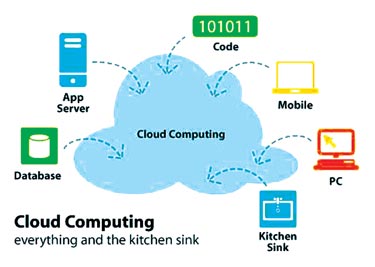A practical look at cloud computing
Lower costs, greater flexibility and
access to resources on demand: it’s no wonder cloud computing is
attracting attention. Oracle’s Country Director - Technology Business
Pakistan and Afghanistan, Oracle Corporation, Farhan Ibrahim discusses
ways in which organizations can take advantage of the benefits of cloud
computing while mitigating risks around security, compliance and quality
of service
Cloud computing has gained traction with an increasing number of
organizations in the past few years. The ability to access a shared pool
of computing resources on demand is proving highly attractive to
cash-strapped IT departments that are under pressure to deliver better
services at lower cost.
The appeal of cloud computing is its promise to deliver agility and
real cost savings. It allows organizations to rapidly access computing
resources when they are needed, often in a self-service and pay-per-use
model. These computing resources can expand and contract with the
natural ebb and flow of the business cycle, eliminating the need to
over-invest in excess capacity.

The building blocks of cloud computing are rooted in hardware and
software architectures that enable resource sharing, such as clustering,
virtualization and dynamic provisioning. Cloud is the evolution of
several proven and mature technologies: grid computing, virtualization,
shared services and management systems.
Many data centers already deploy these capabilities, and are
extending them to the cloud model by adding self-service, auto-scaling
and chargeback.
Oracle offers the industry’s most comprehensive portfolio of grid
computing technologies from applications to disk, that can help
corporate data centers evolve to become private cloud service providers,
delivering secure, high-quality IT services that can be easily scaled
and which comply with organizational and regulatory policies.
Public, private and hybrid clouds
Cloud computing is typically divided into three levels of service
offerings: Software as a Service, where complete applications are
delivered as services to end users; Platform as a Service, where
application development and the deployment platform are delivered as a
service; and Infrastructure as a Service, where server, storage and
network hardware and associated operating system and virtualization
software are delivered as a service.
These services can be provided via public, private or hybrid clouds.
In a public cloud, multiple customers share computing resources provided
by a service provider. Customers are able to access those resources very
rapidly and pay for only the resources used as an operating expense.
This model offers elastic scaling, so resources can be ratcheted up when
needed and scaled back down when they are no longer required.
Although public clouds provide compelling advantages, there are
concerns about security, compliance and quality of service.
Since data is hosted by a third party, customers are trusting the
service provider to keep the data safe from loss or improper access, to
comply with regulations for storage and locality of data, and to deliver
low latency, highly available service over the network.
In a private cloud, the computing resources are for the exclusive use
of a single organization and are controlled by the enterprise. Private
clouds are typically implemented in the organization’s data center and
managed by internal resources, but they may also be managed by a service
provider, in which case they are known as virtual private clouds.
The main benefit of this model is the organization remains in control
of security, compliance and quality of service.
A hybrid cloud is one that spans both public and private clouds for a
single application.
It requires interoperability across clouds and the ability to manage
across both in a unified way. It allows the enterprise to run the steady
state workload in a private cloud and “cloudburst” to a public cloud for
peaks, then return that capacity back to the public pool when it is no
longer needed.
Evolving to the cloud
There are several things to bear in mind when moving to a cloud
model, including the characteristics of specific clouds and the
organizational and cultural issues that might become obstacles to the
adoption of future architecture.An enterprise architecture framework is
valuable to evaluate and design a cloud infrastructure that delivers on
current and future business goals. Such a framework will help architects
define the architectural vision, analyze the systems and technical
architecture designs and incorporate migration planning, governance, and
change management into the overall plan.
At Oracle, we provide technology to help customers build private
clouds as well as run Oracle in public clouds. We also offer several
applications, such as Oracle CRM On Demand, as SaaS services, and
provide Oracle technology to enable other cloud service providers. |



